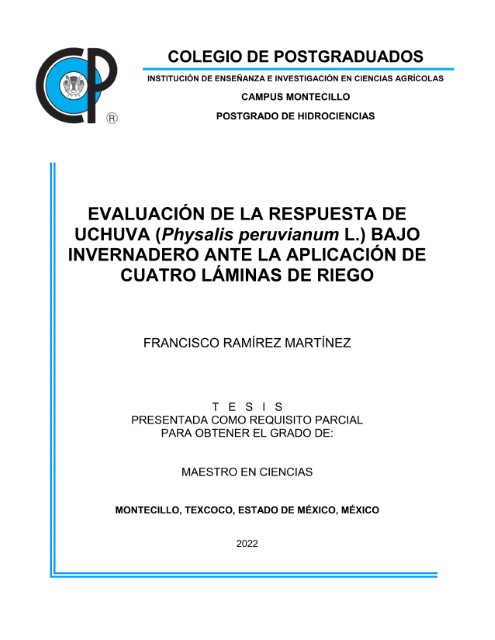
Fecha: 2022-07
Francisco Ramírez Martínez, M. C. Colegio de Postgraduados, 2022
RESUMEN
La uchuva (Physalis peruvianum L.) es una fruta que ha tenido un auge importante
en los mercados de frutos frescos. Los frutos presentan problemas de rajado
asociado a un manejo inadecuado de regímenes de humedad, método y frecuencia de
riego. El objetivo de este trabajo fue evaluar diferentes regímenes hídricos del
sustrato en el desarrollo del cultivo bajo invernadero y su impacto en el
rendimiento, calidad del fruto y productividad del agua. Se implementó un diseño
experimental completamente al azar, aplicando cuatro coeficientes de riego y sus
láminas: 0.86 (2.6, 5.2, 8.3 mm), 1.00 (3.0, 5.9, 9.5 mm), 1.29 (3.7, 7.4, 11.9
mm) y 1.57 (4.4, 8.9, 14.2 mm), en función de la etapa fenológica (vegetativa,
desarrollo-reproducción y producción) con la aplicación de solución nutritiva
Steiner al 100%. El experimento se desarrolló de febrero a octubre del 2021,
cultivando el ecotipo Colombia en tezontle con granulometría de 2 a 10 mm y un
sistema de riego por goteo autocompensado. El mayor rendimiento de 803 g
planta-1, frutos de máximo diámetro de 19.82 mm y una máxima productividad del
agua de 2.3 kg m-3, correspondió al coeficiente 1.29, conservando la acidez
característica del fruto. El menor número de frutos rajados se obtuvo con el
coeficiente 1.57. La función de respuesta del sistema de producción de la uchuva
respondió a la ley de rendimientos decrecientes, calculándose un volumen óptimo
de 0.398 m3 planta-1 y un rendimiento máximo de 3780 kg ha-1.
Palabras clave: calidad del fruto, función de producción, productividad
del agua, rajado del fruto, rendimiento
EVALUATION OF THE RESPONSE OF CAPE GOOSEBERRY (Physalis peruvianum L.) UNDER GREENHOUSE CONDITIONS WITH THE APPLICATION OF FOUR IRRIGATION DEPTHS .
ABSTRACT
Cape gooseberry (Physalis peruvianum L.) is a fruit that has had a significant boom in the fresh fruit markets. The fruits show splitting problems associated with inadequate management of moisture regimes, method and frequency of irrigation. The objective this work was to evaluate different water regimes of the substrate in the development of the crop under greenhouse conditions and their impact on yield, fruit quality, and water productivity. A completely randomized experimental design was implemented, applying four irrigation coefficients and their irrigation depths: 0.86 (2.6, 5.2, 8.3 mm), 1.00 (3.0, 5.9, 9.5 mm), 1.29 (3.7, 7.4, 11.9 mm) and 1.57 (4.4, 8.9, 14.2 mm), depending on the phenological stage (vegetative, development-reproduction, and production) with the application of 100% Steiner nutrient solution. The experiment was carried out from February to October, cultivating the Colombia ecotype in tezontle with a granulometry of 2 to 10 mm and a self-compensated, drip irrigation system. The highest yield of 803 g plant , fruits with a maximum diameter of 19.82 mm, and a maximum water productivity of 2.3 kg m -1 , corresponded to the 1.29 coefficient, preserving the characteristic sourness of the fruit. The lower numbers of split fruits was obtained with the 1.57 coefficient. The response function of the cape gooseberry production system responded to the law of diminishing returns, calculating an optimum volume of 0.398 m 3 and a maximum yield of 3780 kg ha 3 plant -1.
Keywords: fruit quality, production function, water productivity, fruit splitting, yield. -1 .